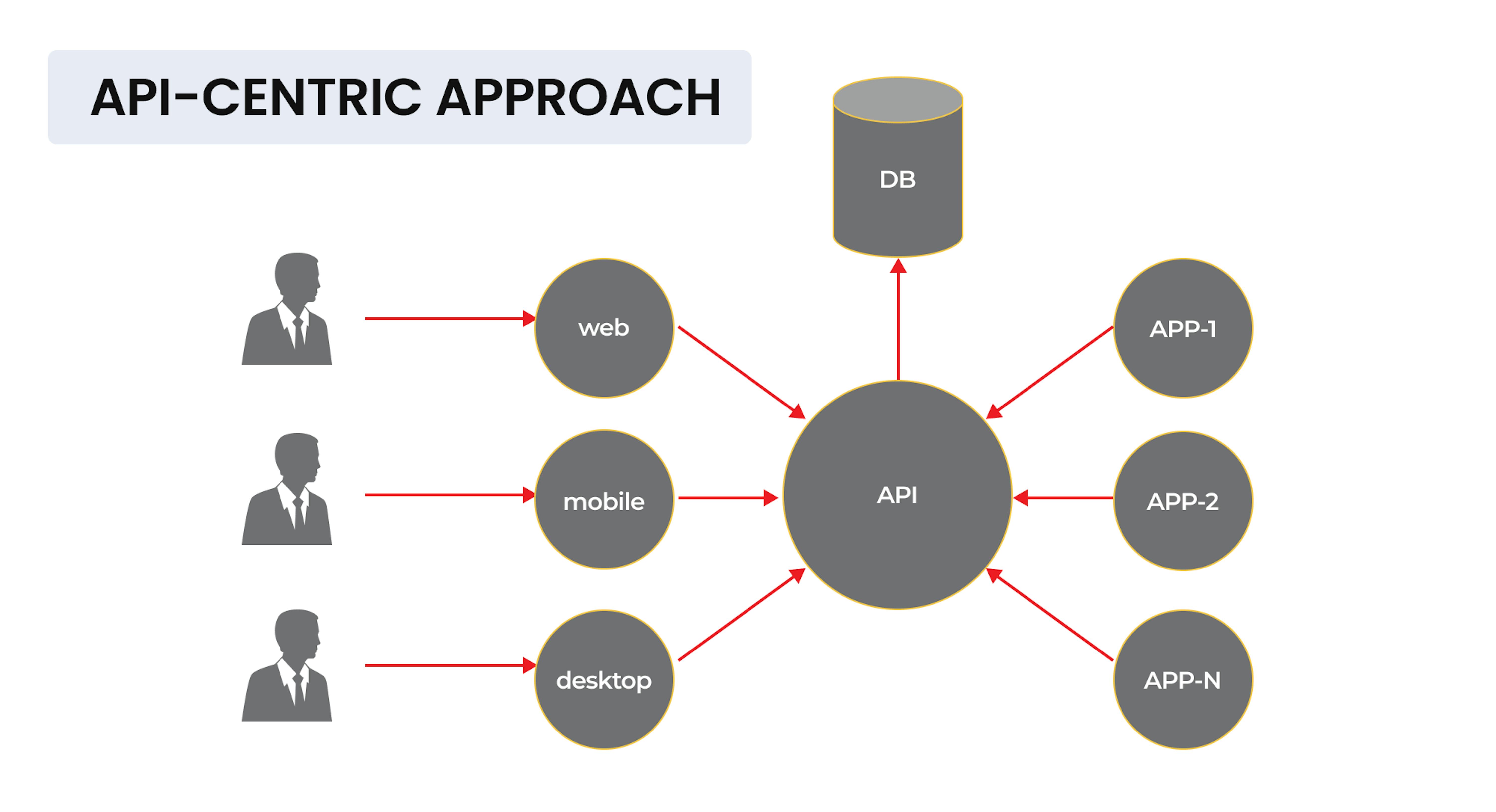A shift occurred in the 2010s, when companies began to view APIs, Application Programming Interfaces, as an independent solution instead of only supporting software. Leading technology companies, such as Google and Instagram, applied this approach to build new and exciting software systems. Soon, other development teams in sectors such as finance, healthcare, and retail adopted an API-first strategy to produce flexible, scalable, and easier-to-maintain solutions. The reasons to do so became clear.
API-first development offers many benefits, a few of which are more efficient development, reusable code, and a consistent user experience across different platforms. Businesses that apply this approach can release new features faster and adapt quickly to market changes. This article will explore these and other advantages, the steps companies can take to implement an API-first approach, as well as advice based on Mad Devs' experience in API-first development.
What is API-first development and how does it work?
An API is an additional software layer that combines requests to the server side of a service to provide simple, fast, and reliable access to its functionality. A common example is Google Maps, which allows food delivery and taxi app users to enter location data. This is how APIs serve as a bridge between different software components. They offer several advantages:
- Simple integrations: APIs make access to services easier and faster.
- Lower component dependency: Problems with third-party service integration don't affect the main service.
- Design flexibility for integrators: An API takes care of this, meaning there is no need to design architecture for integrators.


API-first development represents a fundamental shift in how software is designed and built. Instead of the role of a bridge, APIs have become the primary product and service. Traditional methods start with user interfaces or database designs, but API-first emphasizes that teams define and document APIs before implementation begins. This creates clear agreements between different parts of the system. The API-first approach positions either a custom-built API or the most suitable market-available API at the core of the service architecture. Then, the team develops the infrastructure around the API, with web, mobile, or desktop clients built in accordance with the API specifications.
The shift to the API-first approach came about as a result of a combination of architectural decisions and business strategies. There was an urgent need for an interface between the server part (where all service logic occurs) and everything else. At first, APIs addressed integration problems, but their role expanded significantly over time.
Even large companies with successful monolithic architectures, such as Amazon, Uber, and Netflix, transitioned to this approach. These organizations moved to microservices architecture and developed high-quality APIs, which allowed easier scaling across various platforms. Adoption of this approach is expected to continue with API-first development becoming a standard practice. Trends including AI-driven automation, enhanced security, and the adoption of GraphQL and async APIs will grow as well. Companies like GitHub and Shopify are already leveraging GraphQL to improve API performance.
The core principles of API-first development
The API-first approach relies on several core principles that guide successful implementation. These principles ensure that APIs deliver maximum value while maintaining quality, scalability, and usability. They are also a means of determining whether the stated intention to follow the API strategy is true to the API-first approach.
Start with the API
The first and fundamental principle is to design and build the API before other components. This means creating a complete API specification that defines all endpoints, request/response formats, and behaviors before writing any implementation code. This approach establishes a clear contract between different system components and enables parallel development workflows once the API design is approved.
Treat an API like a product
Successful organizations view their APIs as products with proper lifecycles, roadmaps, and customer bases. This product mindset focuses attention on user experience, adoption metrics, and continuous improvement, as well as developer experience, consistency, versioning strategy, and deprecation policies. Teams that treat APIs as products receive appropriate resources and strategic attention.
Test early and often
API testing should begin during the design phase, not after implementation. Modern API development tools allow teams to mock API endpoints and conduct automated testing against the API specification. This early testing identifies design flaws, usability issues, and potential performance bottlenecks before significant development resources are committed. Continuous testing throughout the development lifecycle ensures the API remains reliable and consistent.
Align API with business requirements
Successful APIs integrate with business goals and requirements. Each API endpoint and feature should map to specific business capabilities and user needs. This alignment ensures the API delivers real value and supports core business functions. Technical teams must collaborate with business stakeholders to understand requirements thoroughly and translate them into appropriate API designs.
Design APIs to be modular, scalable, and reusable
APIs should follow modular design principles, where each component handles a specific, well-defined functionality. This modularity supports reusability across different applications and services. The design should also accommodate future growth through horizontal scaling capabilities and flexible resource models. Forward-thinking API design anticipates future requirements while maintaining backward compatibility.
Organize thorough documentation
Comprehensive documentation is essential for API adoption and effective use. Documentation should include detailed endpoint descriptions, request/response examples, authentication methods, error handling, and policies that limit rates. Well-documented APIs reduce onboarding time and support issues.
Iteration and collaboration
API development benefits from collaboration and regular feedback loops between API designers, developers, and end-users to refine the API over time. Collaborative design sessions, code reviews, and user testing all contribute to API quality. Embracing an iterative approach allows teams to improve the API continuously based on real-world usage patterns and emerging requirements.
These principles serve as an excellent guideline for implementing the API-first strategy and reaping its benefits.
The benefits and drawbacks of API-first development
There are several advantages to adopting API-first development since it matches the desires of developers, businesses, and users well. Similarly, there are drawbacks that businesses need to consider in order to prepare a proper workaround. Large companies, such as the ones mentioned earlier, are turning to API-first development for these reasons:
- Code reuse: The same code functions as service logic for different clients, which reduces development time and ensures consistent behavior. That means cost savings and higher user satisfaction.
- Scalability: Client development for different platforms is fast and cost-effective, which allows companies to expand without spending more development resources.
- Flexibility: New platforms don't force a redesign of the entire service architecture and allow easy adaptation to new user requests
- Reliability: Components operate relatively independently, which means a breakdown in one area does not compromise the whole service.
The disadvantages of this approach challenge certain assumptions connected with more traditional strategies. Once understood, businesses can take steps to ensure their development remains on task and delivers the benefits:
- Poor API quality: There is a risk that some logic may leak to the client, which creates security vulnerabilities and maintenance challenges throughout the application lifecycle.
- Sequential development: Testing teams and developers must wait for API completion to build web, mobile, or desktop clients. This can create bottlenecks in the pipeline.
- Integration phase problems: Some aspects of API development remain unaccounted for until the integration phase, which necessitates bug fixes and additional waiting periods for other developers.
With a strategy to counter these drawbacks, businesses can receive the advantages of API-first development and deliver high-quality services and products to users. It is also likely that as more companies turn to this approach, they will develop solutions to these challenges that others can adopt.
We prepared a succinct visual that highlights the main advantages and disadvantages of adopting API-first development.

6 steps to implement an API-first methodology
The successful implementation of an API-first development strategy requires a structured approach. The key is to establish clear processes and practices to ensure API quality, consistency, and alignment with business goals. The following steps provide a roadmap for teams transitioning to an API-first methodology.
1. Collaborate with API consumers and stakeholders
Begin the API design process with extensive collaboration between technical teams and business stakeholders. This collaboration should identify the needs of potential API consumers, including internal teams, partners, and external developers. Conduct workshops to gather requirements and establish priorities. Document use cases that the API must support and confirm that these align with business objectives. This collaborative foundation ensures the API delivers real value to all stakeholders.
2. Identify API functions and endpoints
Based on the requirements gathered, define the core functions the API must perform. Map these functions to specific endpoints with clear purposes. Determine the resources the API will expose and the operations allowed on each resource. Outline the data models and relationships between different resources. This step transforms business requirements into technical specifications that guide API development.
3. Establish an API contract for each project
Create formal API contracts using specifications such as OpenAPI or RAML. These contracts document all aspects of the API, including endpoints, request/response formats, authentication methods, and error handling. The contract serves as a binding agreement between API providers and consumers. Once approved, this contract becomes the reference point for all development work and can be used to generate client libraries, mock servers, and documentation.
4. Develop an API style guide
Create a comprehensive style guide that establishes standards for API design across the organization. This guide should address naming conventions, versioning strategies, approaches to handling errors, authentication methods, and response formats. The style guide promotes consistency across multiple APIs and improves the developer experience. Reference industry best practices while adapting guidelines to specific organizational needs and technical constraints.
5. Enforce best practices with API governance
Implement governance processes to ensure APIs adhere to established standards and security requirements. Create review workflows for API designs before implementation begins. Conduct regular audits of existing APIs to identify areas for improvement. Establish metrics to evaluate API quality, performance, and adoption. This governance framework maintains consistency and quality as the API portfolio grows.
6. Automate the API generation process
Leverage tools that automate aspects of API development based on the established contracts. Generate server stubs, client SDKs, and documentation directly from API specifications. Implement continuous integration pipelines that validate changes against the API contract. Automate testing to verify that API behavior matches specifications. This automation reduces manual errors, accelerates development, and ensures consistency between documentation and implementation.
By following these steps, organizations can establish a robust API-first approach that delivers high-quality, consistent APIs aligned with business objectives. This methodical implementation creates a foundation for scalable, flexible systems that adapt to changing requirements while maintaining backward compatibility.
The Mad Devs' approach to API-first development
Mad Devs understands the value of an API-first strategy, and one project team practiced this expertise in their recent work with Kintsugi, a company that uses AI to analyze voice biomarkers for signs of various mental health issues. This is a prime example of an API as a product that healthcare providers can use in their products and applications to improve how they identify and treat patients.
Based on this and other experiences, the Mad Devs team can recommend two important considerations that complement the steps mentioned earlier:
- Understand the end users' needs: When an API is a product, the needs of end users take priority in planning and development. This implies a close alignment between business goals and technical requirements, which results in product satisfaction.
- Automate everything: Even if "everything" is too ambitious, teams will benefit from applying automation to as much of the process as possible to ensure the API functions properly to deliver the expected results.
Automation and alignment with business goals help development teams create an API product that can scale as necessary and reach more end users. That means more opportunities to grow the functionality and create other APIs that can match more narrow use cases.
Take advantage of API-first development today
The benefits are clear. API-first development can cut costs and boost scalability and flexibility, two elements that are essential to success in 2025. The number of devices, platforms, and tools that appear yearly is impossible to estimate. Still, companies have saved money without the need to rewrite the architecture of their services every time. Likewise, this strategy makes it possible for startups to launch quickly and gain success, which wasn't as easy to do before without APIs. It's time to reap the benefits of API-first development – get a free consultation with Mad Devs to start today.









